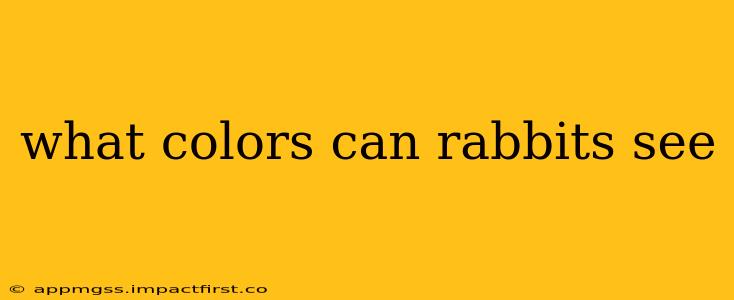Rabbits, those adorable, long-eared creatures, have a fascinating visual system that differs significantly from our own. Understanding what colors rabbits can see involves delving into the intricacies of their eye structure and how their perception of color compares to humans. This detailed exploration will answer common questions about rabbit vision and offer insights into their world.
What is the range of colors a rabbit can see?
Unlike humans who have trichromatic vision (seeing red, green, and blue), rabbits possess dichromatic vision. This means they can only see two primary colors: blue and green. They lack the photoreceptor cells (cones) necessary to perceive the longer wavelengths of light, like red and orange. Their world is essentially a spectrum of blues, greens, and shades of gray. Red objects would appear as shades of gray or dark brown to a rabbit.
Do rabbits see color as well as humans do?
No, rabbits do not see color as well as humans do. Their color vision is significantly less varied. While they can distinguish between shades of blue and green, the richness and vibrancy we experience are absent from their visual perception. Their world is less colorful and more muted compared to ours. This difference is primarily due to the limited number of cone types in their retinas.
Are rabbits colorblind?
While not strictly "colorblind" in the same way some humans are (who may lack the perception of one or more primary colors), rabbits' dichromatic vision is a form of color deficiency. They experience a restricted color palette compared to the broader spectrum perceived by humans and other animals with trichromatic or tetrachromatic vision.
How does their vision compare to other animals?
Many mammals, including dogs and cats, also have dichromatic vision, similar to rabbits. However, some species like primates and certain birds have far more advanced color vision. The evolution of color vision is linked to the animal's ecological niche and its survival strategies. For rabbits, whose primary concern is detecting predators and finding food in varied environments, their current vision serves them adequately.
Can rabbits see in the dark?
Rabbits possess excellent night vision thanks to a higher concentration of rod cells in their retinas. Rod cells are responsible for vision in low-light conditions. While they can't see in complete darkness, their night vision is considerably better than ours, allowing them to navigate their surroundings effectively at dusk and dawn.
Why is understanding rabbit color vision important?
Understanding rabbit color perception is crucial for several reasons:
- Habitat enrichment: Knowing what colors rabbits can perceive helps in designing enriching environments for them. Providing them with toys and surroundings featuring their preferred colors (blues and greens) can enhance their well-being.
- Predator avoidance: The colors they can and cannot see influence their ability to detect predators. This knowledge can inform research on rabbit survival strategies.
- Veterinary care: Understanding their visual limitations can help in designing visual cues and tools for veterinary examinations and treatments.
In conclusion, while rabbits' world is not as vividly colorful as ours, their dichromatic vision is perfectly adapted to their needs. They thrive in their environment, effectively navigating and surviving thanks to their unique visual system. Further research continues to unravel the subtle nuances of their perception, adding to our understanding of this fascinating animal.
